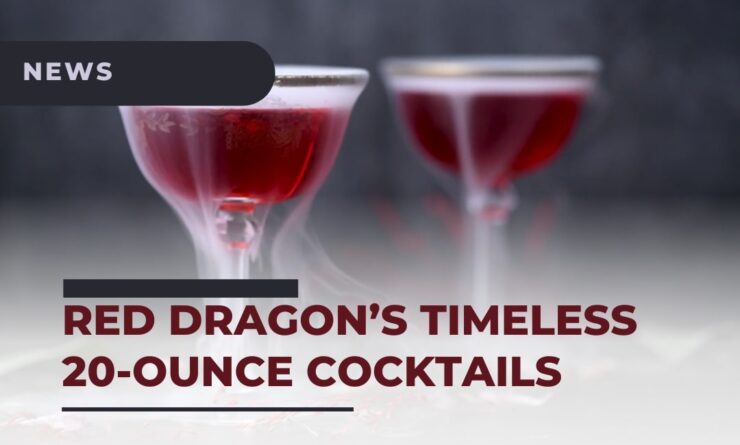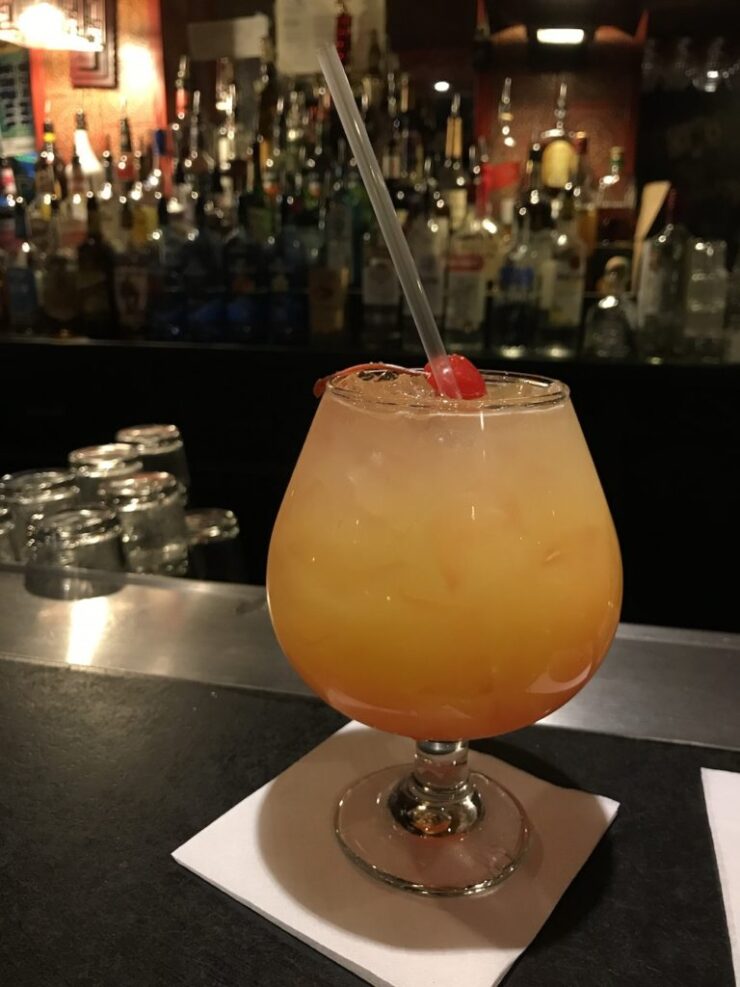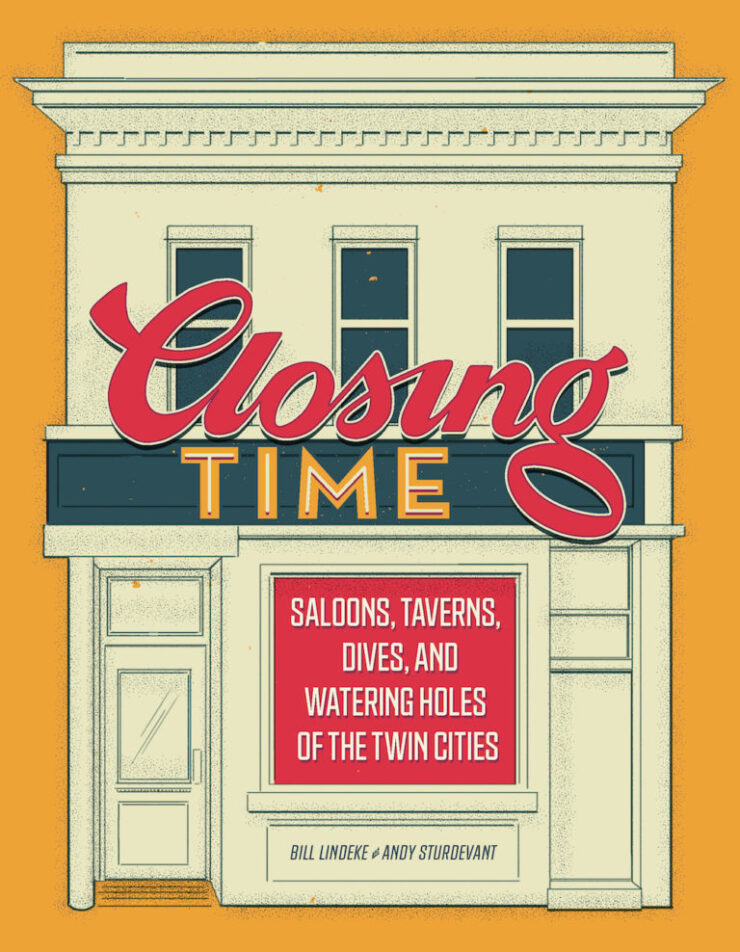The following is excerpted from the recently published book “Closing Time: Saloons, Taverns, Dives, and Watering Holes of the Twin Cities.” The book, published by the Minnesota Historical Society Press, also dives into the histories of The Blue Nile, the CC Club, and the Black Forest Inn.
In one of the far corners of the food internet sometime in the late 2000s, an anonymous poster took it upon herself to re-create, from memory, the Wanderer’s Punch, the drink made famous by the erstwhile Nankin Cafe in Downtown Minneapolis, and where she claimed to have worked. She was used to making the drink in huge batches, so she had to break it down for a home bar.
It’s mostly rum — three kinds — with orange juice and grenadine, served in a fishbowl with some cherries. “Don’t let its pretty pink color fool you,” she warned. “It is called the Wanderer because when you try to get up from your barstool, you commonly find yourself unable to walk a straight line.”
The Wanderer’s Punch itself staggered a not-so-straight line from Downtown Minneapolis to Lyndale Avenue at some point in the 1970s or ’80s — shedding some a’s and e’s, picking up a few o’s, and becoming known as the Wondrous Punch. From when it opened in 1919 to when it closed in 1999, the Nankin Cafe was one of the best-known and most beloved spots in town.
It had grown out of the small but active Chinese American community that had been in Minnesota since 1876, with many of its members running restaurants. By 1910, a few years before the Nankin opened, there were 10 Chinese restaurants in Minneapolis and six in Duluth.
Minneapolis is a town full of small businesses, a perfect place for fulfilling a young man’s dreams.
In the years since the restaurant closed and memories of the Wanderer’s Punch become hazier, the Red Dragon’s Wondrous Punch has taken its place in the local collective consciousness. At one point, a fashionable Downtown bar revived the Wanderer’s Punch using the original Nankin recipe provided by the Wu family, the Nankin’s final owners. It was served in a branded souvenir glass. Very few locals who’ve spent a portion of their lives exploring the city’s bars don’t recognize the Wondrous Punch’s name immediately.
It’s the drink you invoke when you want to tell a story about excess. It’s a Minneapolis original that you can’t believe really exists and seems redolent of another era — an era of much stronger drinks and no pretense to either ironic bemusement or mixological sophistication. The Downtown bar that had revived the Wanderer’s Punch only revived the recipe; they absolutely refused to sell it in a 33-ounce glass like the original at Nankin. Those branded souvenir glasses are 14 ounces. More than that just seemed too much.
The Red Dragon has never worried about crossing such a line. You order a Wondrous Punch at the bar and you get 20 ounces. It is, like the blogger said, a pretty shade of pink. In the dimly lit environment of the Red Dragon, it almost seems to glow. “It’s our policy,” the neon green laminated bar menu reminds you, “that we do not return drinks!!” That extra exclamation mark lets you know you’re truly on your own.
Ask people who remember the Wanderer’s Punch, and they’ll tell you that, despite the similarities in size and ingredients, the potency of the Red Dragon’s version makes the Nankin original seem like a box of apple juice from a school kid’s lunch bag.
The 20-ounce goblets at the Red Dragon are also their own kind of souvenir. A bouncer’s job is always to keep rough characters from coming in, but the Red Dragon bouncers occasionally need to stop drunk patrons from sneaking out with the cherished fishbowl glassware.
Lai Wong opened the Red Dragon in early 1977 in a former dance academy on Lyndale Avenue, where Norwegian ballerina and film star Vera Zorina once rehearsed. Wong had been the head chef at the Nankin Cafe for many years, and he brought with him his culinary expertise — as well as a few cocktail recipes. The dining room side in particular retains the spacious, high ceilings of its earlier iteration.
The Dragon held a grand opening celebration on Super Bowl Sunday, offering free orchids to the first 100 ladies and free beers for every Vikings touchdown during Super Bowl XI, which was being shown on the bar’s TV. The sign on the side of the building read “Polynesian Drinks—Cantonese Food—Szechuan Cuisine.”
By 1976, the tiki cocktail trend was fading a bit nationally from its postwar heyday, though it had really only been established in the Midwest for 10 or 15 years, having slowly moved eastward from Hawaii and California. The Sheraton Hotel downtown had a Kon-Tiki Lounge where you could get mai tais, but the Red Dragon was perhaps the first to offer such fare outside the downtown core.
It was tiki culture directed more at locals living in bungalows and apartments on Bryant and Grand avenues than at traveling businessmen slurping down zombies on corporate expense accounts. The Red Dragon had the standard tiki bar staples, but it dispensed with the mid-century modern bamboo-and-teak cocktail lounge look of a Trader Vic’s and instead went for a more traditional decorative motif that is nonetheless touched with a distinctly mid-’70s sense of weird, unself-conscious excess.
The Dragon is divided into two sections: the bar side and the restaurant side. People drink in both, but the restaurant side tends to shut down earlier, leaving the bar side buzzing until closing time. It all looks very much like it might have in 1976, ’86 or ’96, with the exception of an ATM, some local beers that didn’t exist at the time and a few flat-screen TVs. The TVs are fine and all, but just as entrancing is the wallpaper, a repeating tableau of gold figures from Chinese mythology on a black background, all of which seems to move across the wall the longer you stare at it.
Regulars may be drinking beers at the bar, under the red gabled Chinese-style roof that sits above it, or in the booths along the wall. The main attraction, as ever, is the specialty drink menu. The Wondrous Punch sits at the top, but a whole mix of other similarly sized and apportioned drinks are available, ranging from classics like the Mai Tai and the Zombie to Dragon-specific innovations like the Purple Rain and Molly Ringwald.
The namesakes of the latter two are well chosen. They both place the drinks’ origins straight in the middle of the 1980s, but also within a timeless pop cultural continuum that feels less dated than classic.
A 1998 newspaper profile summarized the scene in a way that still feels familiar today. The bar was notoriously smoky, even for the time. The TV was usually set to westerns or “Xena: Warrior Princess,” while Prince and Sade could frequently be heard on the jukebox. The former is less true these days, but the latter is still broadly true, with a lot more hip-hop mixed in.
“This is the only place I can go to find skinheads, lawyers, gangsters, yuppies and people with piercings and tattoos all together,” said one regular, who identified himself as a law student. “It’s like an escape from Uptown,” said another. “Intimate” is how another described it.
The lack of windows and the emphasis on red — in the wall coverings and trim, the lanterns, the upholstery — gives it an almost womb-like quality. That, mixed with the fuzzy potency of the drinks and the unwelcoming climate outside for half of the year, make the Dragon a bar that feels inviting to an almost transcendent degree.
It’s easy to picture yourself at the Red Dragon on a snowy winter evening at 8 p.m., right before the evening rush, taking it all in and bathed in a red glow, with a fishbowl of booze and a plate of cream cheese wontons in front of you at the bar. It would be hard to think of a more quintessentially Minneapolis setting of the past 40 years.















